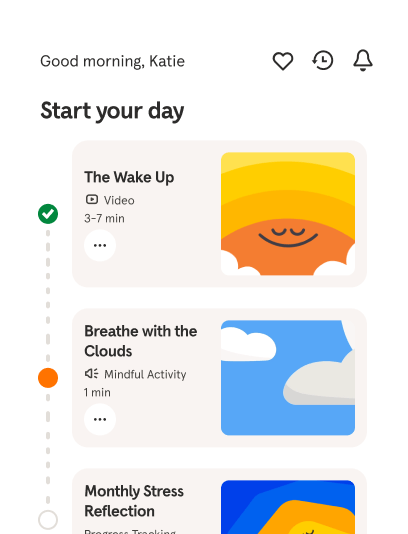Collective and Individual Action
Social ecology expert Dr. Nicole Ardoin explains how communities can become an inspired network of activists, where everyone brings their unique skills to the table.
Try 14 days freeBetter mental health starts with Headspace. Unrivaled expertise to make life feel a little easier, using guided meditations, mindfulness tips, focus tools, sleep support, and dedicated programs.
Try 14 days free
What is that special secret sauce that makes certain communities come together for collective action? (inspiring upbeat music) Hi, I'm Dr. Nicole Ardoin. I'm the Director of the Social Ecology Lab at Stanford University, where we study people's relationships to the environment. Last year, my social ecology lab did a few case studies across the US, looking at areas where community members were highly engaged in climate action. Much of the interview data so far has demonstrated the importance of having shared and dedicated resources, which leads to knowledge spreading far and wide throughout communities. The concept of distributed knowledge means that not every person needs to know everything. Instead, successful community engagement often comes from a network of people who know and bring different things to the table. Think about your own family or circle of friends. Someone might be the expert on keeping up with what's happening with everyone. Someone else might be the expert on making plans, while someone else is the expert on bringing food and making sure everyone is well fed. Our lab is also interested in understanding how we can help create engagement in communities. And again, we find that it all starts with shared resources. For example, urban sociologist Ray Oldenburg wrote about the importance of third spaces. While first spaces are private spaces like your home, and second spaces are workplaces, third spaces are shared communal spaces, where generative work and creativity can flow. What could these third places for climate engagement look like for us? Imagine neighbors, young and old, from different backgrounds coming together in a community garden to weed flower beds, harvest peppers and herbs, and just relax on a sunny weekend afternoon. As kids play and adults talk, the neighbors may express the same concerns about recent weather events, wildfire smoke, or increased flooding. This gathering in a shared space will naturally lead to deeper connections being made, ideas being exchanged, resources being shared, and ultimately, the development of locally relevant climate change solutions. Another emerging theme from our studies is a strong emphasis on emotions and feelings being guiding factors in staying engaged. And we found that people tended to initially get involved for a variety of reasons. For many, it might be due to social norms, like you're doing what you think your neighbors are doing, what you think your neighbors expect you to do. But we found that people often stayed engaged because of the emotional connections. You can do this work with friends and neighbors, and through that, you get excited. People feel like what they're doing makes a difference, especially when we're all doing it together. So what can we tangibly do today or this week to start making an impact on climate change? There are actually so many things you can do, that the array of options can be overwhelming. So I'm a big fan of starting where you are now. Start with what speaks to you. This perspective means you can...
Details
About your teachers
 Andy PuddicomeHeadspace Co-founderMore about Andy
Andy PuddicomeHeadspace Co-founderMore about AndyA former Buddhist monk, Andy has guided people in meditation and mindfulness for 20 years. In his mission to make these practices accessible to all, he co-created the Headspace app in 2010.
 Eve Lewis PrietoHeadspace Director of MeditationMore about Eve
Eve Lewis PrietoHeadspace Director of MeditationMore about EveEve is a mindfulness teacher, overseeing Headspace’s meditation curriculum. She is passionate about sharing meditation to help others feel less stressed and experience more compassion in their lives.
 Dora KamauMeditation TeacherMore about Dora
Dora KamauMeditation TeacherMore about DoraAs a meditation teacher, Dora encourages others to live, breathe, and be with the fullness of their experiences. She loves meditation’s power to create community and bring clarity to people’s minds.
 Kessonga GiscombeMeditation TeacherMore about Kessonga
Kessonga GiscombeMeditation TeacherMore about KessongaKessonga has been an acupuncturists, therapist, and meditation teacher, working to bring mindfulness to the diverse populations of the world.
 Rosie AcostaMeditation TeacherMore about Rosie
Rosie AcostaMeditation TeacherMore about RosieRosie Acosta has studied yoga and mindfulness for more than 20 years and taught for over a decade. Rosie’s mission is to help others overcome adversity and experience radical love.

Your lifelong guide to better mental health
Stress, sleep, and all the challenging emotions — care for your mind with the everyday mental health app that's shown to make a difference.
Try 14 days free
Look after your mind
Proven guided meditations and programs to help you stress less, sleep more soundly, and better navigate life’s challenges

Science-backed
Studies show that using Headspace for 30 days can reduce stress, increase resilience, and improve overall well-being

Explore 1000+ expert-led exercises
Access our library of meditations, breathing exercises, and guidance videos for stress, sleep, focus, everyday anxiety , parenting, and more.




Members are enjoying happier and healthier lives
- © 2025 Headspace Inc.
- Terms & conditions
- Privacy policy
- Consumer Health Data
- Your privacy choices
- CA Privacy Notice


